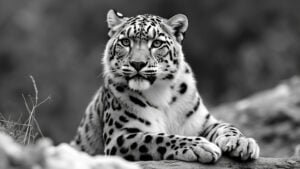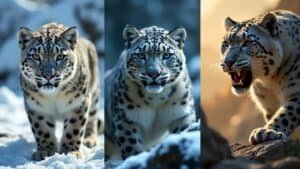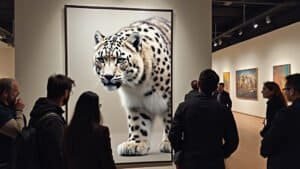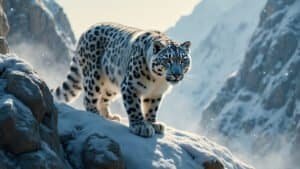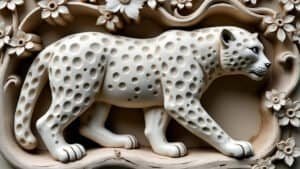Introduction
Capturing the essence of snow leopards in the wild is a challenging yet rewarding pursuit for wildlife photographers
This article delves into the techniques and equipment necessary for tracking these elusive creatures, how to approach them without causing disturbance, and the challenges faced in their rugged, mountainous habitats
Additionally, we’ll explore the essential gear required for such expeditions and the post-processing techniques that bring out the beauty and power of these majestic animals. Finally, we’ll discuss the importance of safety and preparedness in the harsh conditions where snow leopards thrive
Techniques for Tracking Snow Leopards in the Wild
Photographing snow leopards in their natural habitat requires a deep understanding of their behavior and environment
These elusive cats dwell in some of the most remote and rugged terrains on Earth, often at altitudes ranging from 9,800 to 17,000 feet in the mountains of Central Asia. Tracking them requires not just skill and patience, but also a strategic approach that combines traditional methods with modern technology
Understanding Snow Leopard Habitats
Snow leopards are native to mountainous regions, including the Himalayas, the Altai Mountains, and the Tibetan Plateau. These areas are characterized by steep cliffs, rocky outcrops, and vast expanses of snow-covered ground, making it difficult to track these animals
Understanding their habitat is crucial for any photographer hoping to capture their essence. Snow leopards prefer areas with rugged terrain where they can use their natural camouflage to blend into the environment. They are most active at dawn and dusk, when they hunt for prey like blue sheep, ibex, and marmots
Photographers often work closely with biologists and conservationists who study these animals. This collaboration provides valuable insights into snow leopard behavior and movement patterns, enabling photographers to anticipate where the cats might be found
For instance, snow leopards are known to frequent ridgelines and cliff bases, which offer them a vantage point to survey their surroundings and stalk prey. By understanding these preferences, photographers can position themselves in the right location at the right time
Using Camera Traps and Drones
In addition to traditional tracking methods, technology plays a significant role in capturing images of snow leopards. Camera traps, which are motion-activated cameras placed along known wildlife paths, have revolutionized wildlife photography
These devices can be left in the field for extended periods, capturing images of snow leopards without human presence. This not only minimizes disturbance to the animals but also allows photographers to obtain candid shots that would be impossible to capture otherwise
Drones are another tool that has gained popularity in recent years. Equipped with high-resolution cameras, drones can cover large areas and provide aerial views of the snow leopard’s habitat. This perspective is particularly useful in rugged terrains where ground access is challenging
Drones allow photographers to locate potential subjects from a distance and plan their approach accordingly. However, ethical considerations must be taken into account to ensure that the use of drones does not disturb the animals or their environment
Collaborating with Local Guides and Experts
Local knowledge is invaluable when it comes to tracking snow leopards. Photographers often rely on the expertise of local guides who are familiar with the terrain and the behavior of wildlife in the area
These guides can provide critical information about recent snow leopard sightings, preferred hunting grounds, and the best routes to navigate the challenging landscape
In many snow leopard habitats, indigenous communities have coexisted with these cats for generations. Their understanding of the animal’s behavior and their ability to read subtle signs in the environment make them indispensable partners for wildlife photographers
Additionally, working with local conservation organizations can provide access to areas that are otherwise off-limits, increasing the chances of a successful shoot
By combining traditional tracking techniques with modern technology and local expertise, photographers can increase their chances of capturing the elusive snow leopard in its natural environment. However, the key to success lies in patience, persistence, and a deep respect for the animals and their habitat
Approaching Snow Leopards Without Disturbance
Capturing the beauty and essence of snow leopards in the wild requires photographers to approach these elusive creatures with great care. Given their shy and solitary nature, it’s crucial to minimize any disturbance that could disrupt their natural behavior
Success in this endeavor relies on patience, stealth, and a deep understanding of the snow leopard’s environment
Importance of Patience and Stealth
Snow leopards are masters of camouflage, blending seamlessly into their rocky, snowy surroundings. This natural disguise, coupled with their elusive behavior, makes them incredibly difficult to spot
For photographers, patience is not just a virtue but a necessity. It can take days, weeks, or even months of waiting in the field to catch a glimpse of a snow leopard, let alone capture the perfect shot
Stealth is equally important. Snow leopards have keen senses, and the slightest noise or movement can alert them to human presence, causing them to retreat into more inaccessible areas
Photographers often rely on long periods of silent observation, sometimes using blinds or natural cover to remain hidden. Moving slowly and deliberately, especially when near potential snow leopard territory, helps minimize the risk of startling the animal
To further reduce the chances of detection, photographers might choose to wear clothing that blends into the environment, avoiding bright colors or reflective surfaces that could catch the animal’s eye. Additionally, using long lenses allows photographers to maintain a respectful distance while still capturing detailed images
Optimal Time of Day for Close Encounters
Snow leopards are crepuscular, meaning they are most active during the twilight hours of dawn and dusk. These times of day offer the best chances for photographers to observe and photograph these animals as they hunt or patrol their territory
The soft, diffused light during these hours also enhances the photographic quality, reducing harsh shadows and highlighting the textures of the snow leopard’s fur against the rugged landscape
Understanding the animal’s daily patterns is key to planning a successful shoot. Photographers often stake out locations near ridgelines or known hunting paths during these peak activity times. In some cases, they may even follow tracks or scat left behind by the snow leopard earlier in the day to anticipate where the animal might appear at dusk or dawn
Being in the right place at the right time requires not only knowledge of the snow leopard’s behavior but also a willingness to endure long hours of waiting, often in freezing temperatures. The payoff, however, can be extraordinary—a fleeting yet powerful glimpse of one of the world’s most elusive predators in its natural habitat
Minimizing Environmental Impact
Ethical wildlife photography goes beyond just capturing images; it involves ensuring that the photographer’s presence does not harm the environment or the animals within it. When photographing snow leopards, this principle is particularly important due to the fragile ecosystems they inhabit
One of the primary ways photographers can minimize their impact is by following established guidelines for wildlife photography, such as maintaining a safe distance from the animals and avoiding direct interaction. Using equipment like camera traps can further reduce human presence in sensitive areas
Additionally, photographers must be mindful of the potential impact of their activities on the local environment. This includes staying on designated paths to prevent habitat degradation, avoiding the use of artificial lights that could disrupt wildlife, and carrying out all waste to leave no trace of their visit
Essential Equipment for Snow Leopard Photography
Photographing snow leopards in the wild demands not only skill and patience but also the right equipment
Given the harsh and remote environments where these big cats are found, photographers must be well-prepared with gear that can withstand extreme conditions while allowing for high-quality images. The following section explores the critical equipment necessary for a successful snow leopard photography expedition
Choosing the Right Camera and Lenses
A high-quality camera with excellent low-light performance is crucial for capturing snow leopards, particularly because they are most active during dawn and dusk
Full-frame DSLR or mirrorless cameras are preferred due to their larger sensors, which offer better image quality and dynamic range. These cameras also provide the ability to shoot at higher ISO settings without excessive noise, essential for low-light conditions typical of snow leopard habitats
When it comes to lenses, a telephoto lens is indispensable. Given the elusive nature of snow leopards and the need to maintain a safe distance, lenses with a focal length of 400mm or longer are ideal. A lens with a wide aperture (e.g., f/2.8 or f/4) is beneficial for achieving fast shutter speeds, even in low light, and for creating a shallow depth of field that can beautifully isolate the snow leopard from its background
In addition to a primary telephoto lens, having a versatile zoom lens (e.g., 70-200mm) can be useful for capturing the surrounding environment and context shots, which are often as important as close-ups. A wide-angle lens may also be handy for landscape shots that showcase the snow leopard’s habitat
Importance of Camouflage Gear
Blending into the environment is crucial when photographing wildlife, and snow leopard photography is no exception
Camouflage gear helps photographers remain unseen by these sensitive animals, reducing the likelihood of scaring them away and allowing for more natural behavior to be observed and photographed
Camouflage netting, ghillie suits, or specially designed wildlife hides are commonly used. These tools allow photographers to set up in an area without drawing attention. Camouflage gear is not just about visual concealment; it also involves sound and scent
Wearing quiet, non-rustling clothing and minimizing human scent (perhaps by using scent-blocking sprays) can help in getting closer to snow leopards without detection
Additionally, using tripods or monopods with a camouflage finish can help ensure that the photographer’s equipment blends into the environment. Some photographers even camouflage their cameras and lenses using custom covers designed to match the terrain, whether it be snowy, rocky, or forested
Backup Power and Survival Gear
Given the remote and extreme conditions in snow leopard habitats, ensuring that all equipment has adequate power is essential
Cold weather can quickly drain batteries, so carrying multiple spare batteries, preferably kept warm in an inner pocket close to the body, is critical. Solar chargers or portable power banks can also be lifesavers during extended shoots in areas with no access to electricity
In addition to photographic gear, survival equipment is equally important. Snow leopard habitats are often located in high-altitude, remote regions where weather conditions can change rapidly
Photographers need to be equipped with cold-weather clothing, including thermal layers, waterproof outer layers, and insulated boots. A reliable GPS device, a first aid kit, and emergency shelter, such as a bivouac sack, are also essential for safety
Food and water supplies should be carefully planned, with a focus on high-energy, non-perishable items that can withstand cold temperatures. Photographers should also carry a portable stove or means of heating water, as well as a water purification system, since fresh water sources can be scarce and unreliable in snow leopard territories
Challenges and Safety in Snow Leopard Photography
Photographing snow leopards is not just about technical skill and equipment; it also involves overcoming significant challenges related to safety and the extreme environments in which these animals live
From coping with harsh weather conditions to ensuring personal safety in remote and rugged terrains, photographers must be well-prepared to face the unique difficulties that come with capturing these elusive cats in the wild
Coping with Extreme Weather Conditions
Snow leopards inhabit some of the most inhospitable regions on Earth, often found at altitudes between 9,800 and 17,000 feet in mountainous areas like the Himalayas, Tian Shan, and the Pamirs
These regions are known for their harsh and unpredictable weather, which can include extreme cold, heavy snowfall, and strong winds. For photographers, adapting to these conditions is a critical part of the job
Layered clothing is essential to stay warm in freezing temperatures. Photographers typically wear moisture-wicking base layers, insulating mid-layers (such as down or fleece), and windproof, waterproof outer shells
In addition to dressing appropriately, it’s important to protect camera gear from the elements. Snow and moisture can damage delicate electronics, so using weather-sealed cameras and lenses, along with waterproof bags or covers, is vital
Operating camera equipment in cold weather also presents challenges. Batteries drain more quickly in the cold, so having multiple spare batteries and keeping them warm is crucial. Photographers may also need to use hand warmers or specialized gloves that allow for fine motor control while still providing insulation
Additionally, tripods and other metal equipment can become dangerously cold to the touch, requiring photographers to use protective coverings or insulated grips
Ensuring Personal Safety in Remote Areas
Safety is a paramount concern when working in the remote areas where snow leopards are found. These regions are often isolated, with limited access to medical facilities and communication networks. Photographers must be self-reliant and prepared for emergencies
Carrying a reliable GPS device and a satellite phone is essential for navigation and communication in areas without cell service. Photographers should also inform someone of their location and expected return time before venturing into the field
In addition, partnering with local guides or joining an organized expedition can significantly enhance safety, as these individuals are often familiar with the terrain and can assist in emergencies
Physical fitness is another important factor. The high altitudes and rugged landscapes where snow leopards live require a good level of physical conditioning. Altitude sickness can be a serious risk, so acclimatization is necessary before embarking on strenuous activities. Photographers should be prepared for long hikes over difficult terrain, often carrying heavy gear
Emergency supplies, including a first aid kit, water purification tools, and extra food, are also essential. In case of injury or an unexpected delay, having the means to stay hydrated, fed, and warm can be life-saving. Additionally, knowing basic survival skills, such as how to build a shelter or start a fire, can be crucial in extreme situations
Dealing with Unpredictable Animal Behavior
While snow leopards are generally shy and avoid human contact, their behavior can be unpredictable, particularly if they feel threatened or if a mother is protecting her cubs. Understanding animal behavior is key to staying safe and ensuring that photography does not disturb or provoke these powerful predators
Photographers should maintain a safe distance at all times, using long lenses to capture images without getting too close
It’s important to recognize signs of stress or aggression in the animal, such as tail lashing, growling, or a sudden change in body language. If a snow leopard appears agitated, it’s best to retreat slowly and avoid any sudden movements that could trigger a defensive response
Moreover, photographers must be aware of the other wildlife in snow leopard habitats, such as Himalayan wolves, bears, or venomous snakes, which can pose additional risks. Carrying bear spray or other deterrents and knowing how to respond to encounters with these animals is crucial for safety
Lastly, the ethical considerations of wildlife photography must be taken seriously. Photographers should never bait or lure snow leopards, as this can lead to dangerous situations and alter the animal’s natural behavior. The goal should always be to observe and document wildlife without interfering with their natural processes
Post-Processing Techniques for Snow Leopard Images
Capturing images of snow leopards in the wild is only part of the process. To bring out the full beauty and impact of these photographs, post-processing plays a crucial role
This phase involves refining the raw images to highlight the snow leopard’s features, enhance the natural environment, and ensure the final image resonates with the intended audience. The following section details essential post-processing techniques to elevate snow leopard photography
Enhancing Clarity and Detail
One of the primary goals in post-processing wildlife photography is to enhance the clarity and detail of the subject. Given that snow leopards often blend into their environment, it’s important to make sure the cat stands out while still preserving the natural look of the image
The first step is to carefully adjust sharpness and clarity. Using software like Adobe Lightroom or Photoshop, photographers can selectively enhance the details in the snow leopard’s fur, eyes, and facial features. This can be achieved using the sharpening tool or by applying clarity adjustments to specific areas of the image
Noise reduction is another critical step, especially since snow leopard photos are often taken in low-light conditions at higher ISO settings
Tools like Topaz DeNoise AI or the noise reduction feature in Lightroom can help remove unwanted graininess while preserving fine details. It’s important to balance noise reduction carefully to avoid making the image appear overly smooth or unnatural
Finally, selectively enhancing the eyes of the snow leopard can add a powerful focal point to the image. By increasing the brightness and contrast in the eyes, or even adding a subtle catchlight, photographers can draw viewers’ attention directly to the most expressive part of the animal
Balancing Colors and Contrast
Snow leopards are often photographed in environments where the color palette is dominated by whites, grays, and blues. Properly balancing these colors during post-processing is essential to create a visually appealing image
White balance is a key adjustment, especially when dealing with snowy environments. If the image is too cool or warm, it can affect the natural tones of both the snow leopard and its surroundings. Adjusting the white balance to achieve a neutral tone can help bring out the true colors of the landscape and the animal’s fur
Contrast adjustments can also significantly impact the image’s mood. Increasing contrast can make the snow leopard stand out more against its background, while reducing contrast can soften the image, creating a more ethereal or tranquil feel. It’s often effective to use a combination of global and local contrast adjustments—global to set the overall tone and local to fine-tune specific areas of the image
Color grading can further enhance the mood of the photograph. Adding a slight blue tint to the shadows can evoke the cold, harsh conditions of the snow leopard’s environment, while a warm tone in the highlights can add a sense of light and hope. However, it’s important to keep these adjustments subtle to maintain the natural look of the image
Preserving the Natural Look of the Habitat
While post-processing allows for creative enhancements, it’s essential to preserve the integrity of the snow leopard’s natural habitat. Over-editing can lead to an unrealistic portrayal of the scene, which can detract from the authenticity of the photograph
One way to ensure the habitat looks natural is to avoid overly saturated colors or extreme contrast changes that can make the image appear artificial. Instead, aim for subtle adjustments that enhance the existing tones and textures of the landscape
In some cases, photographers may need to remove distracting elements from the image, such as human-made objects or overly bright spots that draw attention away from the snow leopard. This can be done using tools like the clone stamp or healing brush in Photoshop. However, any modifications should be done with care to avoid altering the natural scene too much
Finally, vignetting—a technique that darkens the edges of the photo—can be used to subtly direct the viewer’s focus toward the snow leopard. This can be particularly effective in drawing attention to the central subject without significantly altering the overall composition of the image
Conclusion
Photographing snow leopards in the wild is a formidable challenge that requires not only advanced technical skills but also a deep respect for these magnificent creatures and their environment
From understanding the intricacies of snow leopard habitats and utilizing the right tracking techniques to approaching these elusive animals with care and patience, each step is crucial in capturing their true essence
The journey doesn’t end once the shutter is pressed; post-processing plays a vital role in refining the images to bring out the stunning details and natural beauty of these cats while maintaining the authenticity of their surroundings
Whether dealing with the extreme weather conditions, ensuring personal safety in remote and rugged terrains, or carefully selecting and using specialized equipment, photographers must be fully prepared for the challenges that come with capturing snow leopards in their natural habitats
By blending art with ethics, technology with tradition, and patience with persistence, photographers can create powerful, evocative images that not only showcase the beauty of snow leopards but also contribute to their conservation and the appreciation of wildlife in general


